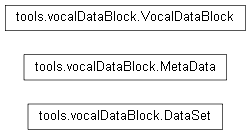Vocal Data Block¶

This file was an attempt by a previous term to set up tabs in Tkinter to simultaneously load multiple levels of data. After spending a lot of time trying to fix all of the problems with this method, I realized I couldn’t get any further and ended up replacing the tabs with a view menu, which is a lot simpler and works much better. All of the fixes I made can be found in the DataBlock branch on GitHub. I would NOT recommend retrying this method, however. I believe there are some limitations from Tkinter and matplotlib/tkinter that would require vocal to be completely restructured for simultaneous tabs to work.
Currently, this file simply serves to load both L1 and L2 files, although it may be prudent to extract the method from VocalDataBlock.get_file_name(), place it in a separate file, and delete this one
-
class
DataSet(in_type, in_data_set, in_x_range=[0, 5000], in_y_range=[0, 20], in_wavelength=532)[source]¶ Class of objects that contain data loaded from HDF files
-
class
MetaData(in_type=0, in_x_min=0, in_x_max=0, in_y_min=0, in_y_max=0, in_wavelength=532)[source]¶ DECREPIT - See comments in source
MetaData objects allow the transfer of rendering range and type info to and from Calipso and VocalDataBlock. The functions allow the code to call or set the current variables